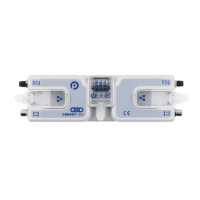Using Logix5000 MSG Instruction
Publication ERSC-1521 Rev 1.0 – February 2019
USING LOGIX5000 MSG INSTRUCTION
Access to ConveyLinx Ai2 modules is also available utilizing the Logix 5000 MSG instruction. The MSG instruction
utilizes CIP Explicit Messaging. This means that the connection is not maintained as an implicit connection. Generic
Ethernet Module and EDS connections are implicit and thus must be maintained at all times or there will be a
communication fault. Explicit Messaging opens the connection, reads/writes data, and then closes the connection
thus freeing up communications resources for the PLC.
WHEN TO USE MSG INSTRUCTIONS
Because the MSG instruction is executed asynchronous to program scan and is not subject to implicit messaging RPI
restrictions; the response time between requesting data and receiving data is not deterministic and can vary
between separate requests for the same data from the same device. Therefore, we recommend that MSG
instructions should not be used for dedicated “real time” control of equipment. For ConveyLinx Ai2 modules, MSG
instructions are intended to gather “low priority” status information and/or to send infrequent parameter changes.
Please note that this is only a recommendation. Your particular application’s specifics, PLC’s capacity, available
network bandwidth, etc. may allow you to get expected results with “real time” control utilizing MSG instructions to
interface with ERSC modules.
REFRESHER ON ASSEMBLIES
The topic of Assemblies is covered in detail in publication ERSC-1506 ConveyL:inx Ai2 PLC
Developer’s Guide
The parameter that is entered in a MSG instruction’s configuration to define the location on the remote device to
read/write data corresponds to a Modbus address in the ConveyLinx Ai2 module. The Ai2 has 512 “Module” Modbus
data registers and these can be thought of as “physical” module address locations. An Assembly is a grouping of
some subset of these 512 Module registers based upon the relevance of the data. For example, the ZPA Input
Assembly groups together 21 Module registers out of the 512 that are relevant for ZPA Inputs. This relevant data
from within the Module 512 registers are not necessarily in consecutive address locations and are scattered
throughout the 512 addresses. The Assembly groups them together so they can be read efficiently all at once.
In publication ERSC-1500 ConveyLinx Ai2 PLC Developer’s Guide, each Assembly chart cross references the Module
Modbus address with its corresponding “Assembled” Modbus address. For example, the ZPA mode inputs are shown
to use Assembled Modbus addresses 4:1500 thru 4:1520. The Assembled Modbus addresses can be thought of as
“virtual”. Assembled addresses cannot be accessed individually; they can only be accessed from the initial boundary
address (i.e. 4:1500 in the ZPA Input Assembly example).

